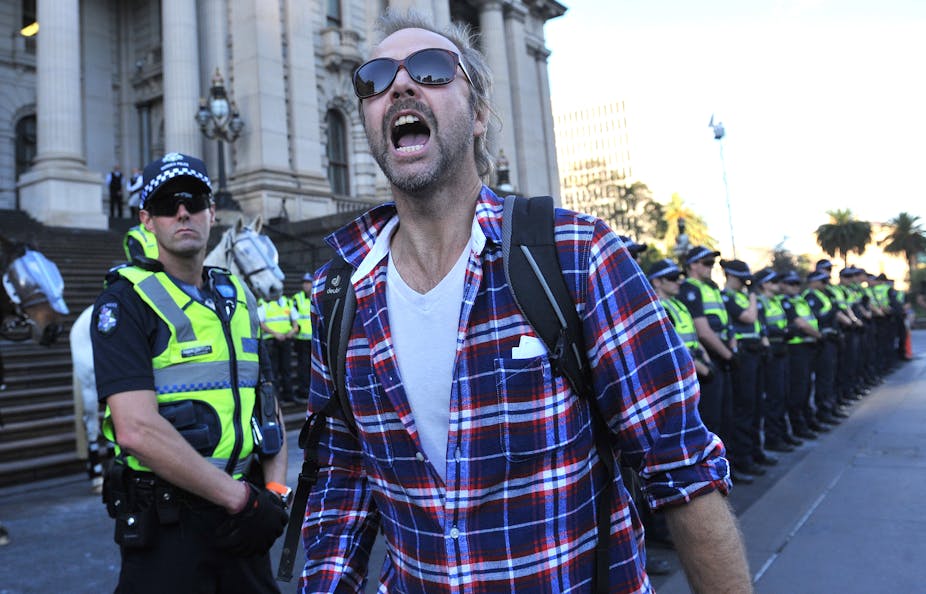Yesterday saw a national day of action by university students protesting against federal budget proposals to increase student fees and interest on student debt.
The protests reportedly led to Prime Minister Tony Abbott and education minister Christopher Pyne cancelling a visit to Victoria’s Deakin University, in a bid to to take the wind out of the protests.
The action, organised by the National Union of Students, follows two recent protests at Melbourne and Sydney universities in which former Liberal MP Sophie Mirabella and foreign minister Julie Bishop were surrounded by protesting students, as well as the infamous incident on the ABC’s Q&A program, when student protesters interrupted the show when Pyne was speaking. The cry from many of the Liberal government and sections of the media has been that student protest is “violent” and “undemocratic”. However the government in Canberra has been saying the same thing about protesting students for the last 45 years.
History of the student protest
The late 1960s saw a rise in radicalism amongst Australian youth, especially as the student population increased. Many of the students were motivated by international events, such as the events of 1968, the Vietnam War and South African apartheid. Others were inspired by issues closer to home, such as the women’s liberation and Aboriginal rights movements.
By 1969, the recently elected (but quite unpopular) John Gorton government were fearful these protests were gaining momentum and could escalate towards ‘Paris-style’ violence (referring to the barricades erected by students in the French capital in May 1968). Under Nigel Bowen, then Thomas Hughes, the Attorney-General’s Department started devising legislation to curb protest in Canberra and on Commonwealth premises – a focal point for protest against the Vietnam War. Archival documents show the Attorney-General believed that new federal laws would then become the framework for similar public order laws across the states. This led to the Gorton government developing the Public Order (Protection of Persons and Property) Act, eventually passed in May 1971.
Public and archival records show that the government was very concerned about the popular tactic of the “sit-in”. Favoured by protesters because it was seen as non-violent, yet effective in disruption, the government debated whether the “sit-in” was a violent act or whether “sitting-in” protesters could be charged with trespassing. Liberal Senator George Hannan complained:
Commonwealth premises have been to some extent an area of no-man’s land… [R]ecently we had in Melbourne people who I would in fact describe as hoodlums but who describe themselves as protesters, who attempted to set fire to wastepaper baskets in the General Post Office.
We have seen in this country in recent times a growth in what has been euphemistically described as ‘sit-ins’. Only the states of New South Wales and Victoria have appropriate legislation to deal with this particular activity.

Any legislation passed by the federal government only concerned the ACT and Commonwealth property. But Hughes felt strict new laws were necessary to “let demonstrators know where they stand” and “make clear the Government’s firm intention to protect citizens from violence”.
In Parliament, Liberal and Country (now National) Party MPs repeatedly referred to demonstrations across Australia to portray a sense of chaos created by student radicalism. In April 1971, when the new laws were being debated, these MPs mentioned ten different protests in Sydney, Melbourne, Brisbane and Adelaide that become “violent”. Liberal backbencher John David Jess warned of the “dangerous” tactics employed by some, such as “people coming into buildings, taking over offices, opening files, distributing documents and terrifying civil servants”.
Some in the Labor opposition defended these protests as legitimate displays of the public’s moral outrage over the Vietnam War, apartheid or racism in Australian society. Future Prime Minister Gough Whitlam said
One cannot expect men and women of 18, 19 and 20 years of age to respect laws which they abominate
Shadow Minister for Trade Jim Cairns also claimed that most of the violence witnessed at protests came from the police, and not from the protesters.
Eventually the government, now under William McMahon, passed its laws against ‘violent’ protest. Throughout 1971, there were three uses of the legislation to combat large demonstrations in Canberra – twice in the week following the law’s passing and once in July against those protesting the South African Springbok tour. However many of those arrested had their charges dismissed by the courts and the law fell into disuse under Whitlam and Fraser.
Although Fraser was the subject of much protest in the late 1970s and early 1980s, he did not go down the same path as Gorton and McMahon. Notoriously, Fraser was barricaded by protesting students at Monash University in August 1976. Yet he was restrained in his response to student protest.
As journalist Gary Newman wrote a few years ago, this was the period when most of today’s politicians cut their political teeth. From this, it is arguable that these experiences of student protest have informed how those presently in government view student politics and protest more widely.
The spectre of student radical, now a ghost on many Australian campuses, still seems to haunt the current Liberal government. It also seems that the government and other media commentators are still using the language of the past to describe the actions of today’s students. But will Abbott and his ministers react like Gorton/McMahon or like Fraser?

